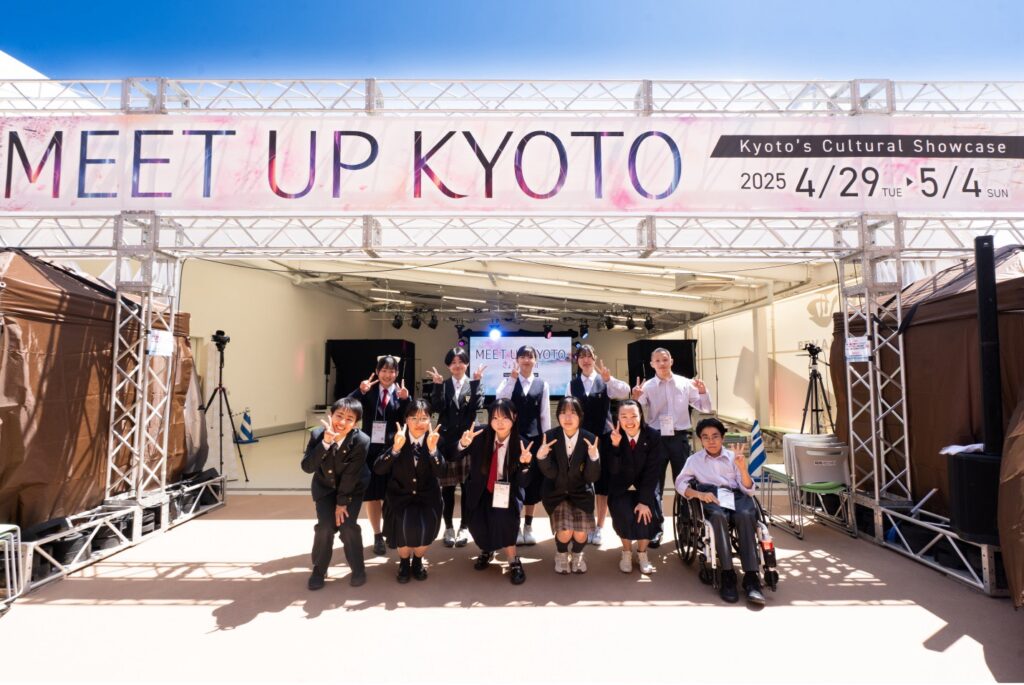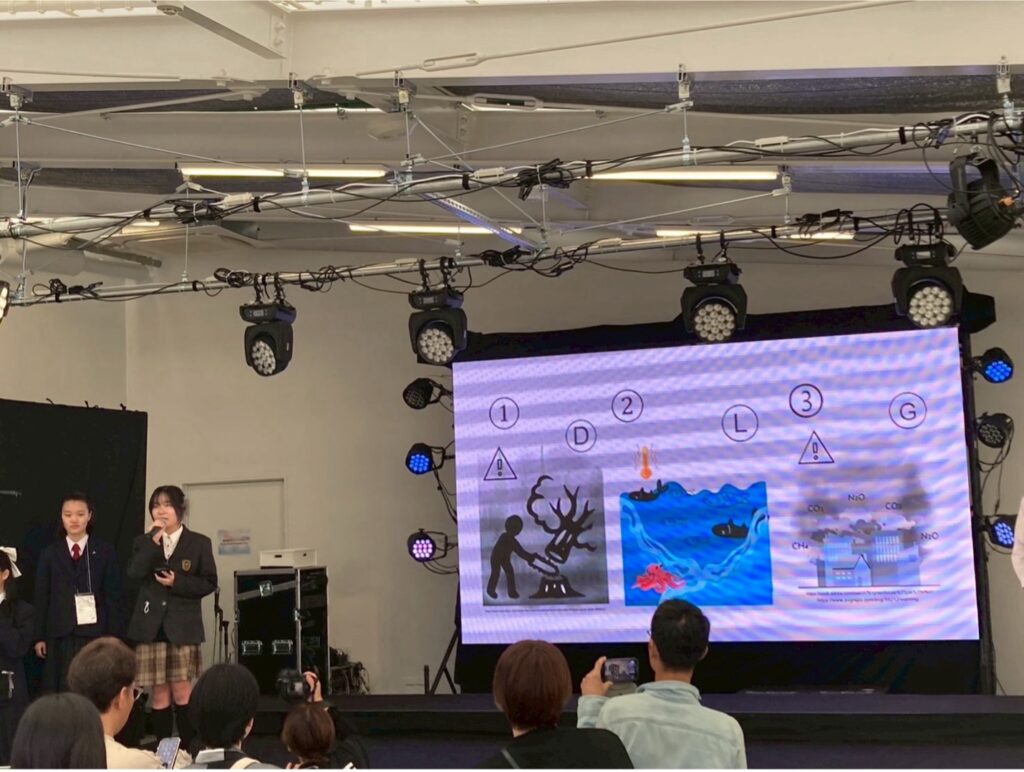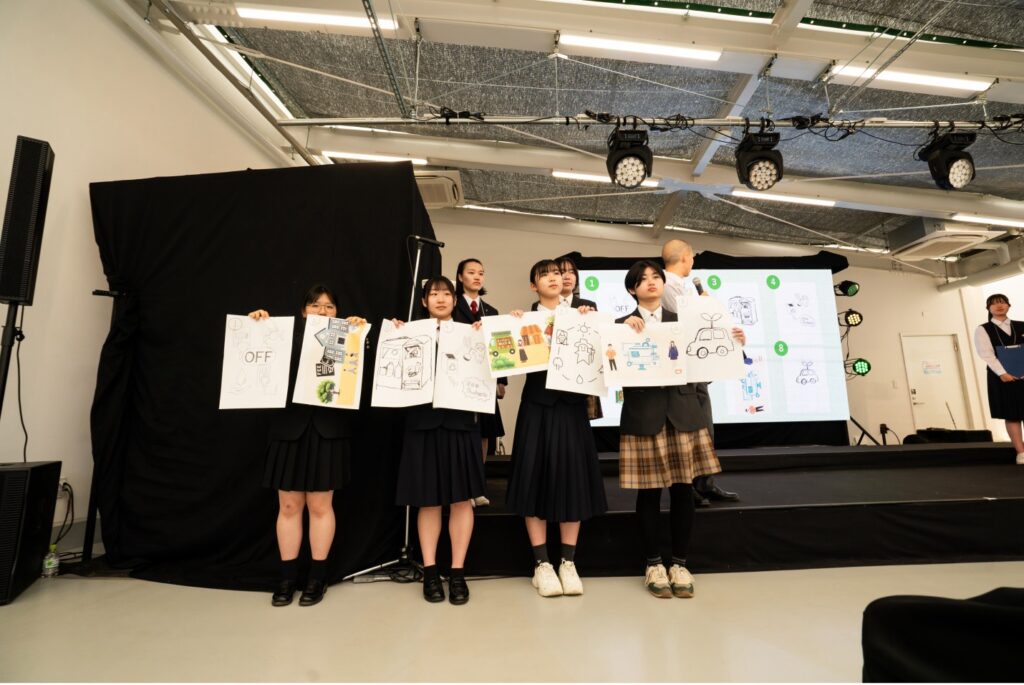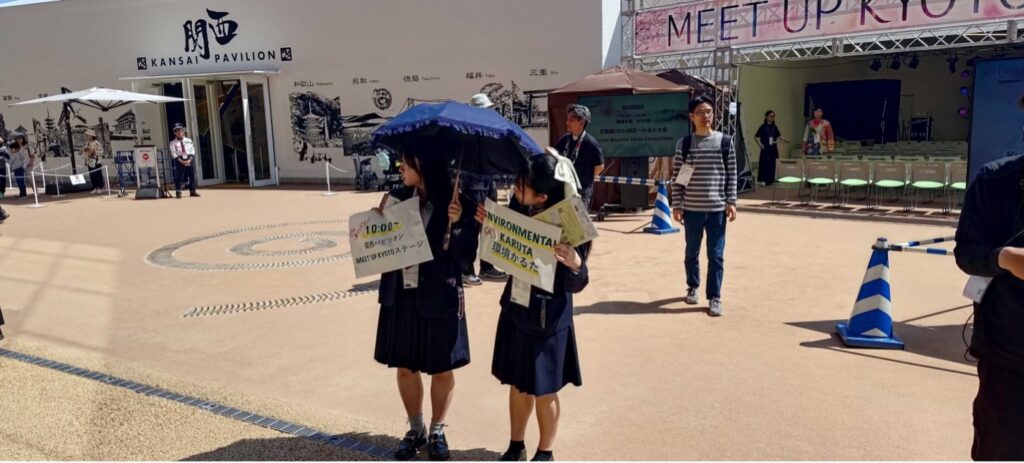* English follows
日本語
2025年5月4日、大阪・関西万博関西パビリオン多目的ホールで行われた MEET UP KYOTO にて、「Earth Youth Summit 2025 in KYOTO」に参加している高校生11名による、「環境かるた」についての発表が行われました。

「環境かるた」とは、日本の伝統的なカードゲームであるかるたを環境問題やその原因や対策に絡めることで、楽しんで気軽に環境について学び、考えることができるように、「地球環境ユースサミット2025 in KYOTO」の中で考案されたものです。
絵札には現代社会における様々な環境問題を表した絵が、読み札にはそれぞれの環境問題についての簡単な説明が記されています。発表者が読み札を読み上げ、観客は、舞台上に提示されたいくつかの絵札の中から読み札に合う絵札を選ぶという、簡単でわかりやすいゲームです。


「地球環境ユースサミット2025 in KYOTO」には、日本各地からのみならず、英語を母国語とする世界中の人々が多く参加しています。全世界の様々なバックグラウンドを持つ高校生が集まり、割り振られたグループの中で知恵を出しあいながら「環境かるた」の作成が行われました。
多くが英語での作業や議論であったために、すれ違いやミスもあったものの、日本語を母国語としない人にも理解がしやすい環境かるたの作成が可能となりました。当日の発表はすべて英語で行われ、関西から世界に届けるという万博のステージにふさわしい発表となりました。
また、「地球環境ユースサミット2025 in KYOTO」では常に念密な事前学習が行われています。具体的には、様々な講師の方から、世界の現状やその対策について学んだり、ロールプレイングゲームなどを通して問題の解決策を共に考えたりといったことがオンラインで行われており、今回の発表内容にもそういった事前学習の内容がしっかりと反映されていました。
また、高校生らによる観客の呼び込みも行いました。イベント前日には、自分たちのSNSアカウントで宣伝しました。当日は、ステージ前でチラシやポスターを手に、発表の内容や良さを自分の言葉で伝えるなど、積極的な呼びかけを行いました。
自分たちが作り上げたプレゼンや思いを一人でも多くの人に伝えたいという熱意が伝えられたと思います。

発表者の一人として、今回の発表について感想を述べさせていただきます。
まず、「環境かるた」の作成及び発表の前に、入念な事前学習の機会があり、そのことによってより伝えたいことや環境問題の本質をとらえることができ、真に観客の皆さんに伝えたいことも明確にすることができたと感じています。
また、当日は、観客席に質問を投げかけたり、手を挙げてくださった方に質問をしてみたり、聴衆のみなさんと密にかかわることができたことを非常にうれしく思っています。
環境問題というと敷居が高いように感じてしまう人も少なくないと思います。環境問題を学ぶとなればなおさらでしょう。
しかし、環境問題は私たちには関係のない話でもなければ難しそうな話でもありません。みなさんが少し意識することで改善することができる問題が現代社会には多くあります。
みなさんも「環境かるた」のように、楽しんで、気軽に、環境問題について考えてみませんか。
執筆: 西京高等学校 藤田 真由南さん、西京高等学校 藤原 由絵奈さん
English
On May 4th 2025, eleven high school students participating in the “Earth Youth Summit 2025 in KYOTO” gave a presentation about “Environmental Karuta” at the Kansai Pavilion’s Meet Up Kyoto Stage.

The “Environmental Karuta” was invented during the activity of “Earth Youth Summit 2025 in KYOTO” to enable people to enjoy learning about and thinking about the environment in a casual manner by relating the traditional Japanese card game of karuta to environmental issues and their causes and countermeasures.
The picture cards were illustrated with pictures representing various environmental issues in modern society, and a brief explanation of each environmental issue was written on the reading cards.
The presenter read out the reading cards, and the audience selected the picture cards that matched the reading cards from among several picture cards presented on the stage screen. It was a simple and easy-to-understand game.


Not only people from all over Japan, but also many native English speakers around the world participate in the “Earth Youth Summit 2025 in KYOTO.”
High school students from various backgrounds from all over the world gathered and created “Environmental Karuta” in each allocated group by putting heads together.
Although there were some miscommunications and mistakes because much of the work and discussion was conducted in English, it was possible to create “Environmental Karuta” that were easily understood by non-native Japanese speakers.
All presentations on the day were made in English, and were appropriate for the Expo’s stage, to deliver “Environmental Karuta” from Kansai to the world.
In addition, “Earth Youth Summit 2025 in KYOTO” involves prior learning. Specifically, we had a chance to learn about the current state of the world and its countermeasures from various lecturers, and also worked together to find solutions to problems through role-playing games and other activities conducted online. The content of this presentation also reflected such prior learning.
High school students also took a lead in attracting audiences to the events. The day before the event, we promoted this event on our social accounts.
On the day of the event, there were active calls for the presentation in front of the stage, with flyers and posters in hand and in our own words to convey the content and merits of the presentation.
I think we were able to convey our enthusiasm to share the presentations and thoughts we had created with as many people as possible.

As one of the presenters, I would like to share my thoughts on this presentation. First of all, we had an opportunity to study carefully before creating and presenting the “Environmental Karuta,” which helped us to better grasp the essence of the environmental issues and to clarify what we truly wanted to convey to the audience.
I was also very pleased to be able to engage closely with the audience on the day, asking questions to those in the audience and to those who raised their hands.
Many people may feel that environmental issues are too difficult to understand. This is even more when it comes to learning about environmental issues.
However, environmental issues are not something that we are not concerned with, nor do they seem difficult.
There are many problems in modern society that can be improved with a little awareness on your part. Why don’t you think about environmental issues in a fun and casual way, just like “Environmental Karuta”?
Written by Mayuna Fujita, Saikyo high school, Kyoto, Japan and Yuina Fujiwara, Saikyo high school, Kyoto, Japan